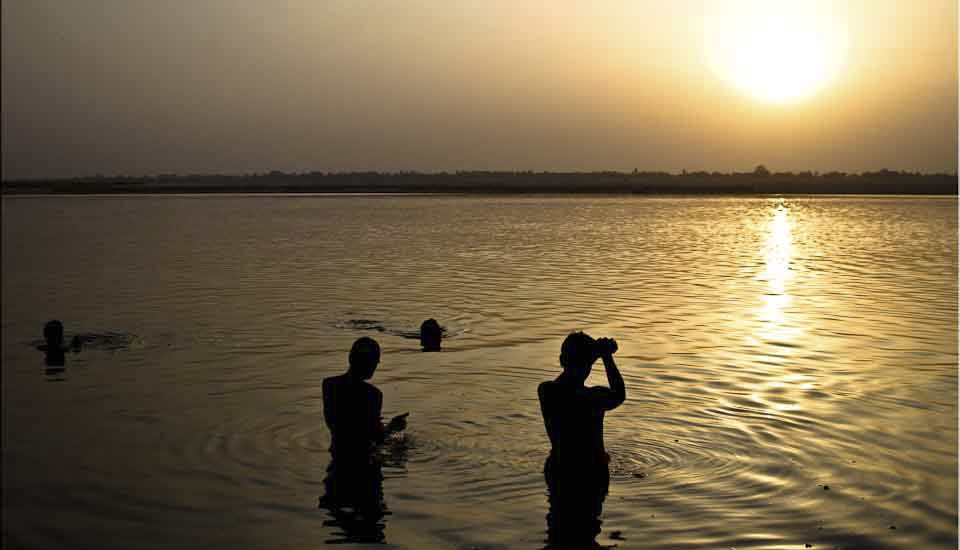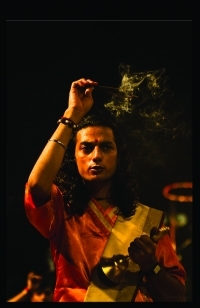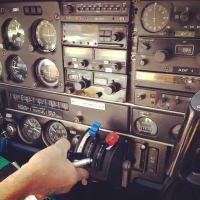.jpg)
Kara Man in Face Paint
The Kara in Ethiopia’s Omo Valley love their jewellery and body art. Men have their left ears notched after initiation and wear special clay caps when they have killed a dangerous animal or an enemy from another tribe.
With about 1400 individuals living across three villages, the Kara are the smallest discrete ethnic group in Ethiopia’s Omo Valley.
They are closely related to the Benna-Bashada-Hamar group and share many linguistic features and cultural practices with these tribes. For example, their young men take part in the Bula, or Pilla, or Bull-jumping ceremony: jumping over the backs of a row of cattle several times in a row to mark their coming of age (see: Coming of Age in a Hamar Village). The women’s skirts and hairstyles resemble those of the Hamar, and the men in both tribes use clay to construct their elaborate headdresses to signify their status, attractiveness, and bravery.
Some stories say that at one time the Kara were connected with the Hamar, but the two tribes migrated in different directions: the Hamar – whom the Kara call “mountain dwellers” – moved up onto the hills in search of better lands and pastures, and the Kara moved downstream towards the Omo River; Kara means “fish” in the local language. The two groups maintain a symbiotic trade relationship.
This is not the case with the more aggressive and more numerous Nilo-Saharan speaking Nyangatom who live on the other side of the river – on lands the Kara say were once theirs. Inter-generational tribal conflicts have continued for decades, and include cattle rustling and bloody battles. Every self-respecting Kara man owns an AK-47.
The Kara are probably best known for their decorative face- and body-painting in chalk and ochre. I’ve shared some pictures of the tribal and their remote village before (see: Visits to a Kara Village).
Come meet a few more of these fascinating people!
.jpg)
Grass Shelter on the Omo
Dus Village, the largest of the three Kara villages, sits on the east bank of the beautiful Omo River Valley.
.jpg)
Elder and the Ceremony House
Only initiated men are allowed into this open structure where the men discuss tribal matters and make community decisions.

Old Man in Silhouette

Young Man in Profile

Warrior in Feathers and Beads
The clay skullcaps that the men wear attached to their hair can take up to three days to construct and need to be replaced after three-to-six months. The men are allowed to wear them for up to a year after a kill to celebrate their bravery.

Men in Body Paint
I’ve posted a similar picture of these men previously (Visits to a Kara Village) because I like how they show the contrasting styles of body-patterns in use.

Almost Abstract : Body Paint
The Kara paint themselves daily, building up their preferred design in white chalk, coloured ochre, yellow mineral rock, charcoal, and/or pulverised iron ore.

Time and Focus
Men and women alike love layers of beads. I didn’t see any mirrors: …

Young Women Face Painting
… I did see a lot of people painting each other.

Bottom Lip Incision
It is not uncommon for Kara women, men, and even children, to wear a nail, a stick, or a piece of grass sticking out of their chin through an incision made under their bottom lip.

Spurting Liquid
It is also not uncommon to see people expelling liquid through this incision.

Dus Woman with a Gourd
Calabash gourds are common utensils in the village.

Woman Preparing Sorghum
Women and children sit in the dirt, going about their daily chores.

Hand in the Sorghum
Kara are primarily an agriculture-based society, growing sorghum, corn, pumpkin, and beans – some of which they trade with the Hamar.

Hands in the Sorghum
Sorghum is a versatile grain, and is a dietary staple for the Kara.

Woman and Child
Sorghum is cooked into the daily porridge, using milk or water. It is also fermented to produce the local beer.

Still Life Found : Clay Pots on the Ground

Men in Red
All over the world, young men love their sporting gear.

Smiling Ethiopian Man
That smile! And those distinctive Ethiopian curls.

Women and Children
All around the village, women and their children gather in groups.

Boys outside the Bar
Meanwhile, a group of young men is gathered with their beers outside one of the community buildings. It is barely seven thirty in the morning!

Still Life Found : Bowl and Bales

Mother and Child
Flowers and grass are inserted into lip and ears, …

Woman with Flowers
… or tucked into headbands.

Warrior
Ostrich feathers are a finishing touch to the warriors’ clay skullcaps.

Elegant Woman in a Hut
How I wished I could have had a proper conversation with some of these women! (Off-Camera Flash)

Mother and Infant in a Hut
The huts are hot and dark, even in the mid-morning, and there is not much in the way of “belongings” inside. (Off-Camera Flash)

Young Woman in a Hut
This is another face I’ve shared before (Visits to a Kara Village): I just loved her solemn expression. (Off-Camera Flash)

Woman in Spots
There is a cheeky flirtatiousness in some of these expressions; I can’t help but wonder what these women think as they meet our gaze.
As the smallest tribal group, the Kara have learned to negotiate trade – and peaceful co-existence – with their more-numerous neighbours.
They are also trading with us: marketing their unique appearance for small handfuls of tourist dollars.

I can’t help but wonder how much of their cultural heritage they can preserve into the future.
And, I wonder what they actually think about it all!
Here’s to their future.
Photos: 20October2018


































.png)


[…] Our camp was close to Dus Village, the largest of three Kara villages in Ethiopia; the majority of Kara people live in South Sudan or the Central African Republic. Some of the villagers helped around the camp, or sat in the shade, engaging in their beading or face- and body-painting. This added to my feeling of being in the middle of things. Our location also meant we were able to visit the village a number of times, and therefore could spend time with the locals as they went about their daily lives (see: Visits to a Kara Village and The Kara of Dus Village). […]
[…] side of the Omo River – on lands the Kara say were once theirs. As I have written before (see: The Kara of Dus Village), inter-tribal conflicts have continued for generations. Men need to show their ability to […]